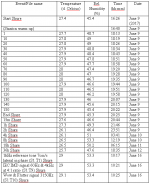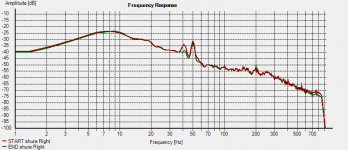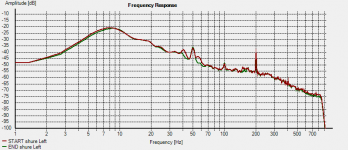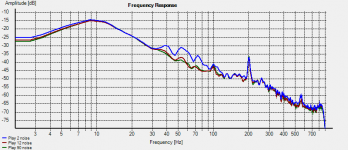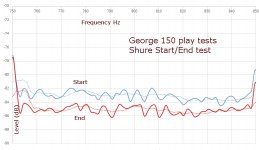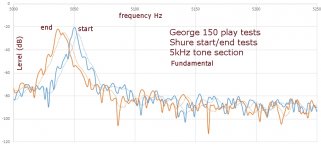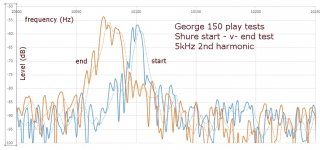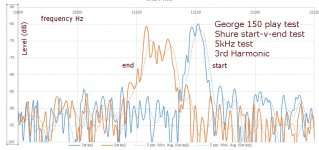Re: x150 plays test
The remaining of the files for downloading
91-120
https://www.dropbox.com/sh/w5idzhua7b21pyx/AAA1aDB2rOrn848F618Dzelta?dl=0
121-150
https://www.dropbox.com/sh/fvwwhs5jpaekn1w/AAB-dHV2lnATEc3l29OsDOm0a?dl=0
Shure files
https://www.dropbox.com/sh/n440cjacn6zpe6f/AADSHNoq-TQvDnshW-ls6zhXa?dl=0
George
The remaining of the files for downloading
91-120
https://www.dropbox.com/sh/w5idzhua7b21pyx/AAA1aDB2rOrn848F618Dzelta?dl=0
121-150
https://www.dropbox.com/sh/fvwwhs5jpaekn1w/AAB-dHV2lnATEc3l29OsDOm0a?dl=0
Shure files
https://www.dropbox.com/sh/n440cjacn6zpe6f/AADSHNoq-TQvDnshW-ls6zhXa?dl=0
George
Maybe we are through to the other side ?That's a lot for polishing to account for. TT issues????.
I just had a sneak peak comparing 2nd and 85th files, trying to work out the best long term way of analysing them.
Looking at the whole files for low frequency cart-arm stability seems sensible. A quick look suggested significant improvement for the 85th play over the 2nd, which similar progressive effect was observed in George's 2.5g 300Hz tests.
Again using the complete files to look at noise floor in the 750Hz-850Hz range, outside of the test range and free of most artifacts, suggested significant improvement for the 85th play over the 2nd play.
Both these effects can be markers for reduced stylus-groove friction, IME.
Looking at the 5kHz portion of the files only, it was necessary to select a section free from a large click event which seems to happen on all files. Amplitude of the 5kHz test tone relative to the noise floor and cart-arm resonant system suggests this test is quite quiet or moderate in terms of modulation.
Briefly comparing 2nd and 85th fundamental 5kHz test tone amplitudes suggested no significant difference. However, both 2nd and 3rd harmonic distortion increased significantly for the 85th play over the 2nd play, which IIRC is consistent with Shure's observations in a similar experiment at 6kHz. But inconsistent with George's 2.5g test results at 300Hz and Shure's tests at 1kHz, which showed progressive improvement for 3rd harmonic.
So I think this methodology for slicing the test files into frequency specific bits, and analysing them is OK, the best approach I think, as Pano has already started. But, being MM/MI, it's difficult to observe 3rd harmonic distortion much above 8kHz fundamental because of electrical roll-off.
I'm intending to analyse distortion at 1kHz and 5kHz spots, and tone amplitude only at 10kHz and 20kHz spots. Plus LF cart-arm stability and noise floor 750Hz-850Hz across the whole file. How does this seem as a start ?
LD
Some notes on the x150 play test
Proof cartridge: ShureM97xE (brush raised) playing with 1.5gr VTF
X150 play cartridge: Stanton MKV D5 playing with 2.5gr VTF
Kenwood KD-3100 turntable, to Hagerman Bugle RIAA pre, to M-Audio Audiophile USB card. 24bit/96KHz recordings.
Test track: Side 1 Track 6 stepped sweep 1 kHz to 20 kHz at -20dB, Mono (Lateral)
from Analogue Productions “The Ultimate Analogue test LP” (*)
Wave editing SW: Steinberg Wavelab
---------------------------------------------------------
TT and electronics warmed up for two hours. Cartridges were not exercised.
I first played the test track with the Shure cartridge. This is the first proof recording named as “Start Shure”. It is to show the condition of the test track before the x150 plays.
Then I installed and adjusted the Stanton cartridge. I warmed it up by playing for 90 minutes a music vinyl LP (Lightning Hopkins).
Then I started playing and recording the test track for the planned x150 times (**).
I was raising and dropping the cartridge manually.
For to reduce the loss in case of a possible pc problem (***),instead of doing one recording for all the x 150 plays, I made one recording for every 30 playbacks. During the 1min of each recording saving , I was brushing the needle with a soft brush. I wasn’t cleaning the vinyl record.
I was keeping notes on number of times and for temperature and humidity notes were every 10 recordings.
After completing the x150 recordings, I immediately changed cartridge shells, made the adjustment and did a recording of the test track with the Shure. This is the “End Shure”. It is to show the condition of the test track after the x150 plays.
Then I did a series of delayed plays/recordings with the Shure on the test track and finally I recorded three other tracks from the same test LP. One is the 1kHz reference tone 7cm/s lateral in phase (S1 T1), the other is the IEC IMD signal 60Hz & 4kHz at 4:1 ratio (S1 T9) and the third is a Wow & Flutter signal 3150Hz (S1 T10), all with the Shure.
All the Stanton recordings I’ve linked to, are sections cut from the long x30 recordings. Each raw section was about 40sec long from needle drop to needle raise.
I first removed the rear section after the test signal decay (approx 5sec long) and then I removed the initial needle drop and the subsequent impulse decaying low frequency vibrations plus some ( total approx. 3sec long), intentionally entering into the initial 1kHz test signal for to reduce the smearing of the sub frequencies -which Lucky pays much attention to- in the final recording.
Then all the sections were time aligned (+/- 2samples anchor point at the rear of the recording) and a 1.5ms fade in/fade out was applied.
This doesn’t mean that one recording can be sample aligned along it’s full length with another recording. They are time aligned to such an extend only around the anchor point. But this is all one can do with vinyl.
The same editing was applied to the Shure proof individual recordings
The finished test recordings are all 31s 250ms (3M samples) long.
During the whole time of this exercise, the test LP has not been moved from it’s position on the TT platter. This is to minimise the variation from play to play of the subsonic content (due to eccentricity and warp)
(*) Cut on a Neumann VMS 80 lathe with a newly rebuilt SX-74 cutterhead at Sterling Sound and pressed at Record Technology, Inc. on high-quality, 180-gram virgin vinyl.
(**) The planned number was 150 plays. So are the recordings I kept.
(***) Which of course happened to an extend. After having saved the 2nd x30 plays recording, I continued recording. I had counted 15 more plays when the notebook pc went blank and not responding , like entering hibernation mode.
It took some 1,5 minutes to restore pc operation (cartridge was continuing to read the test disk) and in my anger I decided on the fly to drop the recovered recording with the 15 plays as a not to be trusted data file (stupid but I did it) and start a new recording.
So what is saved as #61 play in the distributed recordings, is physically the 61+15play, so are all the subsequent recorded plays. Keep that in mind when analyzing the recordings, if there is a step change in behavior between the #60 and the #61 recording, it will be due to the added -but not shown- 15 more plays between these two .
In case that someone will need the original long, unedited recordings (the so called "dirty fingerprints" ), I can upload them in two-three days. Just ask.
), I can upload them in two-three days. Just ask.
George
Proof cartridge: ShureM97xE (brush raised) playing with 1.5gr VTF
X150 play cartridge: Stanton MKV D5 playing with 2.5gr VTF
Kenwood KD-3100 turntable, to Hagerman Bugle RIAA pre, to M-Audio Audiophile USB card. 24bit/96KHz recordings.
Test track: Side 1 Track 6 stepped sweep 1 kHz to 20 kHz at -20dB, Mono (Lateral)
from Analogue Productions “The Ultimate Analogue test LP” (*)
Wave editing SW: Steinberg Wavelab
---------------------------------------------------------
TT and electronics warmed up for two hours. Cartridges were not exercised.
I first played the test track with the Shure cartridge. This is the first proof recording named as “Start Shure”. It is to show the condition of the test track before the x150 plays.
Then I installed and adjusted the Stanton cartridge. I warmed it up by playing for 90 minutes a music vinyl LP (Lightning Hopkins).
Then I started playing and recording the test track for the planned x150 times (**).
I was raising and dropping the cartridge manually.
For to reduce the loss in case of a possible pc problem (***),instead of doing one recording for all the x 150 plays, I made one recording for every 30 playbacks. During the 1min of each recording saving , I was brushing the needle with a soft brush. I wasn’t cleaning the vinyl record.
I was keeping notes on number of times and for temperature and humidity notes were every 10 recordings.
After completing the x150 recordings, I immediately changed cartridge shells, made the adjustment and did a recording of the test track with the Shure. This is the “End Shure”. It is to show the condition of the test track after the x150 plays.
Then I did a series of delayed plays/recordings with the Shure on the test track and finally I recorded three other tracks from the same test LP. One is the 1kHz reference tone 7cm/s lateral in phase (S1 T1), the other is the IEC IMD signal 60Hz & 4kHz at 4:1 ratio (S1 T9) and the third is a Wow & Flutter signal 3150Hz (S1 T10), all with the Shure.
All the Stanton recordings I’ve linked to, are sections cut from the long x30 recordings. Each raw section was about 40sec long from needle drop to needle raise.
I first removed the rear section after the test signal decay (approx 5sec long) and then I removed the initial needle drop and the subsequent impulse decaying low frequency vibrations plus some ( total approx. 3sec long), intentionally entering into the initial 1kHz test signal for to reduce the smearing of the sub frequencies -which Lucky pays much attention to- in the final recording.
Then all the sections were time aligned (+/- 2samples anchor point at the rear of the recording) and a 1.5ms fade in/fade out was applied.
This doesn’t mean that one recording can be sample aligned along it’s full length with another recording. They are time aligned to such an extend only around the anchor point. But this is all one can do with vinyl.
The same editing was applied to the Shure proof individual recordings
The finished test recordings are all 31s 250ms (3M samples) long.
During the whole time of this exercise, the test LP has not been moved from it’s position on the TT platter. This is to minimise the variation from play to play of the subsonic content (due to eccentricity and warp)
(*) Cut on a Neumann VMS 80 lathe with a newly rebuilt SX-74 cutterhead at Sterling Sound and pressed at Record Technology, Inc. on high-quality, 180-gram virgin vinyl.
(**) The planned number was 150 plays. So are the recordings I kept.
(***) Which of course happened to an extend. After having saved the 2nd x30 plays recording, I continued recording. I had counted 15 more plays when the notebook pc went blank and not responding , like entering hibernation mode.
It took some 1,5 minutes to restore pc operation (cartridge was continuing to read the test disk) and in my anger I decided on the fly to drop the recovered recording with the 15 plays as a not to be trusted data file (stupid but I did it) and start a new recording.
So what is saved as #61 play in the distributed recordings, is physically the 61+15play, so are all the subsequent recorded plays. Keep that in mind when analyzing the recordings, if there is a step change in behavior between the #60 and the #61 recording, it will be due to the added -but not shown- 15 more plays between these two .
In case that someone will need the original long, unedited recordings (the so called "dirty fingerprints"
George
Attachments
First whizz through of the book done (lots of time to kill in hospital). Very interesting as much of what is written is of its time (1965) and audiophile nonsense such as moving coil cartridges were not of interest. Also the extreme stylus profiles didn't exist so a 0.5mil conical was considered to be as good as needed (ellipticals are mentioned but not given much space). Also the word 'esteemed' is used a lot as befits the age  . Anyway my first take aways
. Anyway my first take aways
1. He assumes a rigid cantilever. We now know this to be wrong
2. He is broadly in agreement with LD over friction.
3. Once you are under 1mg effective tip mass record wear is not an issue at under 3g tracking force. But with the caveat that it includes resonant effects.
4. polishing (or more burnishing) the vinyl does occur and is not a bad thing
5. He believes that elastic deformation occurs and as long as the elastic limit is not exceeded it can be ignored.
6. the arm and turntable are significant contributors to the noise level.
Reading that on the back of the Weinz papers and I do wonder if, once you are at a 5x40um profile if there is any benefit in going more extreme other than playing mangled vinyl. Sort of counter intuitive that you use the most expensive stylus on the most worn records as makes no odds on the good stuff
1. He assumes a rigid cantilever. We now know this to be wrong
2. He is broadly in agreement with LD over friction.
3. Once you are under 1mg effective tip mass record wear is not an issue at under 3g tracking force. But with the caveat that it includes resonant effects.
4. polishing (or more burnishing) the vinyl does occur and is not a bad thing
5. He believes that elastic deformation occurs and as long as the elastic limit is not exceeded it can be ignored.
6. the arm and turntable are significant contributors to the noise level.
Reading that on the back of the Weinz papers and I do wonder if, once you are at a 5x40um profile if there is any benefit in going more extreme other than playing mangled vinyl. Sort of counter intuitive that you use the most expensive stylus on the most worn records as makes no odds on the good stuff
(lots of time to kill in hospital).
With our first daughter we decided to to be "green" and do the old school diaper pail thing. Didn't last long.
I thought about it for 10 minutes with #1 as by the mid 90s there were delivery services who took the buckets away and gave you clean stuff in return. It was not a hard choice. The shame is that nappies (bar the plastic outer) are eminently compostable, but the collection is a problem and makes the economics not work. I feel bad for all the extra landfill I have caused but boiling terry cloths is hardly good for the planet either.
If you are referring to the Walton book ..... of its time (1965) and audiophile nonsense such as moving coil cartridges were not of interest. Also the extreme stylus profiles didn't exist so a 0.5mil conical was considered to be as good as needed (ellipticals are mentioned but not given much space).
Don't forget he was a Decca man so would have spurned the MC Ortofons .. especially as he was achieving much smaller 'ETM'.
Not sure how you got this impression. The construction & working of both the Deram and the FFSS MI cartridges relied on bendy cantilevers.1. He assumes a rigid cantilever. We now know this to be wrong
That's how he got low 'ETM' on the cheapo Deram.
The cantilever resonances of the FFSS MI cartridges was subject to much agonising at the time .. especially as there was little damping. This wasn't only a problem at the arm/cartridge resonances but also showed clear clamped cantilever resonances within the audio range that would make lucky drool
There's a lot of sense in this. I remember an article proposing a 'fine line' stylus specifically for playing 78s... I do wonder if, once you are at a 5x40um profile if there is any benefit in going more extreme other than playing mangled vinyl. Sort of counter intuitive that you use the most expensive stylus on the most worn records as makes no odds on the good stuff
But Decca did introduce an elliptical stylus for the Deram soon after the book.
___________
To sum up 1970s opinion .. the Deram wasn't quite as nice sounding as the best & latest Shures/Ortofons/ADCs but would be as kind or kinder to your records as the best V15 of the day.
If you were a poor music lover, you should use a Deram while you saved your pennies for an Ortofon SL15E + transformer or V15
Loadsa articles on how to get the best out of the Deram in dem days.
Last edited:
I fixed the click by hand. And it seemed worse on the right than the left, so I used just the left track.Looking at the 5kHz portion of the files only, it was necessary to select a section free from a large click event which seems to happen on all files.
I have sectioned the Stanton #1 and Stanton #150 recordings into their 27 individual frequency sections. It will help to study the amplitude of the fundamental tones and their harmonics.
Sectioned files are also manually declicked.
Stanton #1 sectioned
https://www.dropbox.com/sh/v2tvox42mpcm07z/AAB3Zdd2GJr6dpjuLaL3WvJ3a?dl=0
Stanton #150 sectioned
https://www.dropbox.com/sh/rlcqvjgyt2uyd12/AADvpiPQY9ZLI9UN4TgWJzKYa?dl=0
Later I will do the same for the Start Shure and End Shure proof recordings.
George
Sectioned files are also manually declicked.
Stanton #1 sectioned
https://www.dropbox.com/sh/v2tvox42mpcm07z/AAB3Zdd2GJr6dpjuLaL3WvJ3a?dl=0
Stanton #150 sectioned
https://www.dropbox.com/sh/rlcqvjgyt2uyd12/AADvpiPQY9ZLI9UN4TgWJzKYa?dl=0
Later I will do the same for the Start Shure and End Shure proof recordings.
George
That's a lot of work George! Thanks for doing that.
Lucky - I took a look at noise below 850Hz on the Shure start and end files. There just isn't much difference as far as I can tell. Start and End on each graph, a graph for left and another for right channel. This noise has been amplified by 40 dB so the hump at the low end is 20 dB below the 1K test tone level.
The only differences that shows is a little difference in mains noise. Let me know if these are helpful.
Lucky - I took a look at noise below 850Hz on the Shure start and end files. There just isn't much difference as far as I can tell. Start and End on each graph, a graph for left and another for right channel. This noise has been amplified by 40 dB so the hump at the low end is 20 dB below the 1K test tone level.
The only differences that shows is a little difference in mains noise. Let me know if these are helpful.
Attachments
Yes, I agree that's true for the Shure files, run before and after the 150 plays on the Stanton. But there's significant difference (improvement) between 2nd and 85th files for the Stanton 'test in play', which is all I've looked at so far (busy ripping the last few of George's files). I looked at the range 750Hz to 850Hz.Lucky - I took a looked at noise below 850Hz on the Shure start and end files.
Perhaps it's possible that what we see in the Stanton tests is compounded by stylus wear or progressive cartridge changes? But early days yet, and best to reserve judgement methinks. But certainly significant progressive changes, generally improvements (?!), are present in the first half of the Stanton files, and a quick look suggests absent from the Shure 'before/after 150 plays on the Stanton' test.
LD
A first careful indication seems to be that the record is not changing its properties at all, but that the cartridge (suspension) is the cause, since the Shure shows no difference while the Stanton does.
With the previous series of test performed with the Shure, similar things happened then as by now with the Stanton.
Or am I jumping to conclusions too rapidly ?
Anyhow, a big compliment to George for his meticulous labour and his patience.
Hans
With the previous series of test performed with the Shure, similar things happened then as by now with the Stanton.
Or am I jumping to conclusions too rapidly ?
Anyhow, a big compliment to George for his meticulous labour and his patience.
Hans
Thank you all. I am happily doing the benchwork but don’t forget , this is a collaborative project.
First is Ricardo who triggered our verification desire with his input that vinyl playback causes degradation of track’s HF content and it needs time to recover.
Then is Hans who asked to think if we should look at the cartridge and not at the vinyl as the main suspect for the consistent change during repeated playbacks.
It is Michael who described the method of using two cartridges for verifying if it is the vinyl or the cartridge that is causing the change.
It is Lucky that is suggesting the method and probably doing the bulk of data analysis.
And I too think that the interpretation of the early analysis is in favor of Hans suggestion.
It seems the weak link is not the vinyl.
But we are only at the beginning of the analysis.
George
First is Ricardo who triggered our verification desire with his input that vinyl playback causes degradation of track’s HF content and it needs time to recover.
Then is Hans who asked to think if we should look at the cartridge and not at the vinyl as the main suspect for the consistent change during repeated playbacks.
It is Michael who described the method of using two cartridges for verifying if it is the vinyl or the cartridge that is causing the change.
It is Lucky that is suggesting the method and probably doing the bulk of data analysis.
And I too think that the interpretation of the early analysis is in favor of Hans suggestion.
It seems the weak link is not the vinyl.
But we are only at the beginning of the analysis.
George
Well, I've just been looking at the 5K tone and its harmonics from the 1st plays to the last.
As far as I can see, there is no change in the 5K fundamental. The harmonics H2, H3, H4 do change, but the change looks identical from Shure to Stanton.
I suspect vinyl wear, not cartridge changes. Let's see what Lucky's analysis brings.
As far as I can see, there is no change in the 5K fundamental. The harmonics H2, H3, H4 do change, but the change looks identical from Shure to Stanton.
I suspect vinyl wear, not cartridge changes. Let's see what Lucky's analysis brings.
Here's some analysis of the 5kHz section of the Shure before/after test, with 150 back-back plays on the Stanton in between. I used the section from 16.35 seconds to 17.1 seconds to avoid a big click event in both files.
Noise in the 750H-850Hz range, averaged across the whole file, shows about 2dB improvement for the 'end' test over the 'start'. This is statistically significant, and therefore probably real. A similar improvement was observed in progressive tests 300Hz@+12dB for George's Stanton 2.5g tests previously. If one looks at the waveforms visually, one can see obvious reduction in peak noise excursions for the end test over the start.
Amplitude of the 5kHz test tone is similar between end and start files. Attached is a plot which includes point averaged lines, by way of smoothing, which suggests end amplitude is within 1 dB of start amplitude: there is no significant amplitude/energy difference IMO. The turntable has slowed down between start & end tests, BTW
2nd harmonic distortion is similar between end and start files. See attached pot. There's some suggestion IMO that 2nd harmonic distortion is slightly increased in the end file, but within reasonable error bars the files are similar.
3rd harmonic distortion is similar between start and end files. See attached plot. If one visually integrates to find total energy in the peaks, one can see the results are similar, though there seems to be more FM (lower Q) in the after file, possibly due to speed variation?
LF stability is similar between start/end files. George, is there external damping present ?
So the most significant changes in the Shure before/after test seem to be improvement to average noise floor in the after file in the 750Hz-850Hz region, and slowing down of the turntable probably with associated wow/flutter (!).
I think this supports Hans' and George's suggestion that there's no significant change to the vinyl shown in this 5kHz after 150 plays on the Stanton at 2.5g, apart from perhaps improvement to noise floor, consistent with polishing?
This outcome is different to previous Stanton tests @300Hz+12dB which showed other progressive changes, mostly improvements, as tentatively did the progressive files of the 150 plays in a quick look, but the is the next step to analyse. I think this points to Stanton test results being associated with changes to cartridge rather than vinyl, but let's see the Stanton analysis before concluding.
All interesting stuff !
LD
Noise in the 750H-850Hz range, averaged across the whole file, shows about 2dB improvement for the 'end' test over the 'start'. This is statistically significant, and therefore probably real. A similar improvement was observed in progressive tests 300Hz@+12dB for George's Stanton 2.5g tests previously. If one looks at the waveforms visually, one can see obvious reduction in peak noise excursions for the end test over the start.
Amplitude of the 5kHz test tone is similar between end and start files. Attached is a plot which includes point averaged lines, by way of smoothing, which suggests end amplitude is within 1 dB of start amplitude: there is no significant amplitude/energy difference IMO. The turntable has slowed down between start & end tests, BTW
2nd harmonic distortion is similar between end and start files. See attached pot. There's some suggestion IMO that 2nd harmonic distortion is slightly increased in the end file, but within reasonable error bars the files are similar.
3rd harmonic distortion is similar between start and end files. See attached plot. If one visually integrates to find total energy in the peaks, one can see the results are similar, though there seems to be more FM (lower Q) in the after file, possibly due to speed variation?
LF stability is similar between start/end files. George, is there external damping present ?
So the most significant changes in the Shure before/after test seem to be improvement to average noise floor in the after file in the 750Hz-850Hz region, and slowing down of the turntable probably with associated wow/flutter (!).
I think this supports Hans' and George's suggestion that there's no significant change to the vinyl shown in this 5kHz after 150 plays on the Stanton at 2.5g, apart from perhaps improvement to noise floor, consistent with polishing?
This outcome is different to previous Stanton tests @300Hz+12dB which showed other progressive changes, mostly improvements, as tentatively did the progressive files of the 150 plays in a quick look, but the is the next step to analyse. I think this points to Stanton test results being associated with changes to cartridge rather than vinyl, but let's see the Stanton analysis before concluding.
All interesting stuff !
LD
Attachments
Last edited:
Here's some analysis of the 5kHz section of the Shure before/after test, with 150 back-back plays on the Stanton in between. I used the section from 16.35 seconds to 17.1 seconds to avoid a big click event in both files.
Thanks Lucky
I need some hours more for to provide the sectioned files of the Start Shure and End Shure recordings. The interim info for the ~5kHz section is:
Shure Start file: From 16s 180.937ms to 17s 260.719ms (f=5040Hz)
Shure End file: From 16s 177.323ms to 17s 258.813ms (f=5049Hz)
(try to measure the freq of the fifth harmonic and divide by 5)
George, is there external damping present ?
No. The M97xE brush was locked in raised position. The arm has no damping provision (a typical S Japanese arm from the 70ies)
George
Thanks Lucky
I need some hours more for to provide the sectioned files of the Start Shure and End Shure recordings. The interim info for the ~5kHz section is:
Shure Start file: From 16s 180.937ms to 17s 260.719ms (f=5040Hz)
Shure End file: From 16s 177.323ms to 17s 258.813ms (f=5049Hz)
(try to measure the freq of the fifth harmonic and divide by 5)
Thanks, the slicing saves a lot of time. I think it's best to choose sections without big clicks, if that's possible, but never mind if you've already started. I'm intending to analyse 1kHz and 5kHz for tone amplitude and harmonic distortion, and 10kHz and 20kHz just for tone amplitude, though I'll have a look at 10kHz harmonic distortion too.
LD
Last edited:
OK Lucky, looks pretty much like what I found, too.  Good to see confirmation. As I said in post #1216, is looks like vinyl changes, not cartridge. And the vinyl changes are very small, remarkably so, considering what we are normally led to believe about LP wear.
Good to see confirmation. As I said in post #1216, is looks like vinyl changes, not cartridge. And the vinyl changes are very small, remarkably so, considering what we are normally led to believe about LP wear.
Thanks for seeing the speed change, I also saw it, but wasn't sure of my results.
What I have noticed is that the later plays are not as "clean" as the early ones. By that I mean the early plays have harmonics as sharp spikes. At the end they are spread across 3 or more FFT bins. You don't see this on lower frequencies, but it's consistent at higher frequencies. I do not know what would cause that, turntable flutter - vinyl wear, ADC clock jitter (unlikely).
 Good to see confirmation. As I said in post #1216, is looks like vinyl changes, not cartridge. And the vinyl changes are very small, remarkably so, considering what we are normally led to believe about LP wear.
Good to see confirmation. As I said in post #1216, is looks like vinyl changes, not cartridge. And the vinyl changes are very small, remarkably so, considering what we are normally led to believe about LP wear.Thanks for seeing the speed change, I also saw it, but wasn't sure of my results.
What I have noticed is that the later plays are not as "clean" as the early ones. By that I mean the early plays have harmonics as sharp spikes. At the end they are spread across 3 or more FFT bins. You don't see this on lower frequencies, but it's consistent at higher frequencies. I do not know what would cause that, turntable flutter - vinyl wear, ADC clock jitter (unlikely).
- Home
- Source & Line
- Analogue Source
- mechanical resonance in MMs
